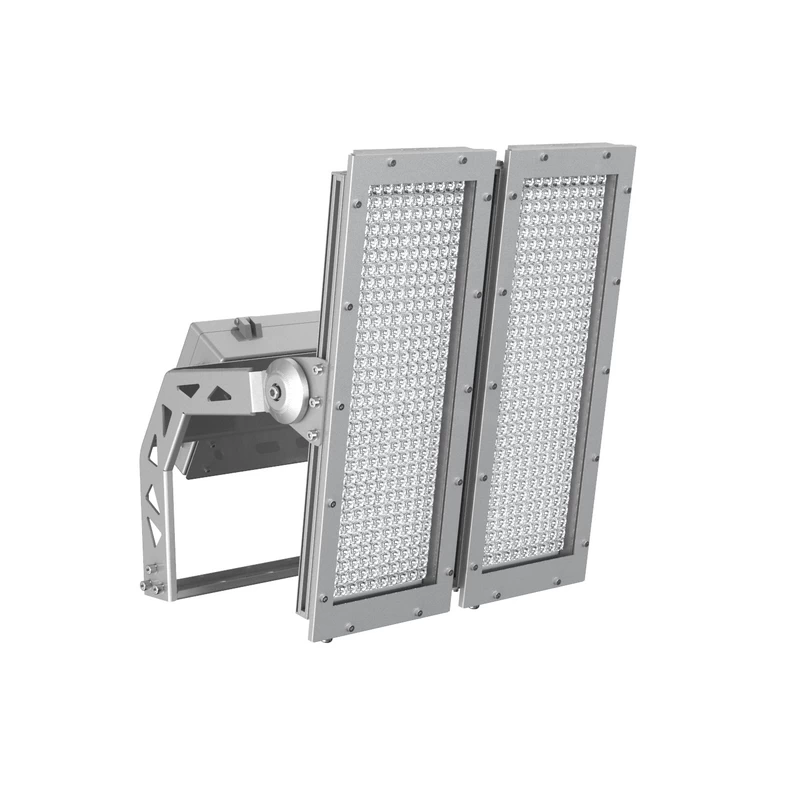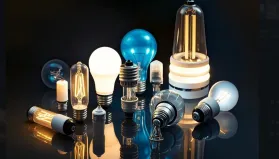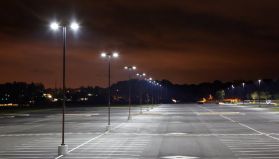目次
トグルはじめに
工場、商業ビル、スタジアムなど、その他の産業スペースの美観、機能性、安全性において、照明の取り付けは重要な役割を果たします。埋め込み型、表面型、吊り下げ型など、照明の設置タイプはそれぞれ、環境や特定の要件に応じて独自の利点を提供します。この包括的なガイドでは、各取付タイプの照明の主な違い、利点、欠点、設置プロセスについて説明します。
ライト取り付けタイプ
工業用や業務用の照明器具を選ぶ際には、どの取り付けタイプがそのスペースに最も適しているかを理解することが重要です。例えば倉庫では、吊り下げ式で広範囲を照らすハイベイライトを使うかもしれない。工場フロアでは、表面に取り付けられた器具の方が、強力なタスク照明に適しているかもしれません。
照明器具の取り付けは、埋め込み型、表面型、吊り下げ型に大別できる:
- 埋め込み型:器具は表面に埋め込まれ、多くの場合天井に設置される。
- 表面取り付け:ライトは表面自体に取り付けられます。
- 吊り下げ式:器具を天井または他の構造物から吊り下げる。
それぞれを詳しく調べてみよう。

埋め込み型取付照明とは?
埋め込み式取り付けとは、天井や壁の内側に取り付ける器具のことで、器具本体が隠れていることを意味します。以下のことが可能です。 埋め込み型照明の詳細.
埋め込み照明とは?- 天井や壁の開口部に器具本体を隠し、光源だけを露出させた照明器具のことです。器具本体をあまり目立たせたくない場合に最適です。

埋め込みマウントの利点:
- 美しくシンプル:空間に強い印象を与え、天井とシームレスに調和し、視覚的にすっきりとした美しさを生み出す。
- 光の方向を制御可能:光は特定のエリアに正確に向けることができます。
- 高い安全性:露出部分がなく、衝突の心配がない。
- 掃除が簡単:ライトが完全に隠れるので、ホコリがたまりにくい。
埋め込みマウントの欠点:
- 複雑な設置:正確なカットが必要で、天井のスペースが大きい。
- 放熱が悪い:器具が天井に囲まれているため、放熱スペースが限られている。
- メンテナンスが難しい:器具の交換やメンテナンスが面倒。
- コストがやや高い:プロ仕様の埋め込み式器具はより高価で、天井のカットや配線にも費用がかかる。
埋め込みマウントの用途:
| アプリケーションエリア | 典型的なスペース | 照明目標 | 推奨埋め込み照明 |
|---|---|---|---|
| インダストリアル | 工場、倉庫、生産ライン | 高輝度、ワイドカバレッジ、耐久性 | ハイベイ埋め込み器具、LEDパネル |
| コマーシャル | オフィス、小売店、ホテル、レストラン | 視覚的な快適さ、ブランドを高める雰囲気、エネルギー効率 | ダウンライト、ウォールウォッシャー 埋め込み型LED照明 |
| レジデンシャル | リビングルーム、キッチン、バスルーム、廊下 | アンビエント照明、タスク照明、低グレア | 小口径ダウンライト、スポット調整可能 |
| スポーツ | 屋内アリーナ、ジム、プール | 高照度、グレアコントロール、均一性 | 高出力埋め込み式フラッドライト、グレアシールドダウンライト |
表面実装ライトとは?
表面取り付けとは、器具を埋め込むことなく、天井や壁に直接取り付けることを意味します。コンクリート天井や天井高が限られているなど、構造上の問題で埋め込み式が実用的でない場所では、表面取り付け式照明が好まれることが多い。
LEDは今や表面実装照明の主流です。弊社では、LED三眼レフライトやLEDリニアライトなど、プロフェッショナルなLED表面実装照明を提供しています。スポーツ施設、商業施設、工業施設に最適です。 お問い合わせ 無料のカスタマイズ照明ソリューションのために。
表面実装の利点:
- 簡単な取り付け:既存の天井や壁に直接取り付けられるため、最大限の適応性が得られます。
- ポジショニングと動きの面でより柔軟性がある。
- メンテナンスが容易:ランプが露出しているため、分解やメンテナンスが容易。
- 広範な放熱が長寿命を保証。
表面実装の欠点:
- 埋め込み式ほど美観は良くない。
- 建築デザインによっては、視覚的に乱雑になることがある。
- 目は発光面を直視しやすくなり、グレア(まぶしさ)を引き起こす。
表面実装の用途:
| アプリケーションエリア | 典型的なスペース | 照明目標 | 推奨サーフェスライト |
|---|---|---|---|
| 産業&ユーティリティ | 倉庫、作業場、機械室 | 高ルーメン出力、耐久性、容易なメンテナンス | 表面実装LEDバテン、 LED蒸気密閉器具 |
| 小売・商業 | ショップ、スーパーマーケット、ショールーム | 製品ハイライト、均一な周囲光、視覚的快適性 | 面実装トラックライト、LEDリニアライト |
| レジデンシャル | キッチン、廊下、バルコニー、寝室 | 簡単な取り付け、一般的な照明、装飾的なスタイル | フラッシュマウントシーリングライト、装飾ライト |
吊り下げ式照明器具とは?
吊り下げ式は、ロッドやワイヤー、チェーンを使って天井から照明器具を吊り下げる方法です。このタイプの照明は、倉庫やスタジアムなど、天井の高い空間でよく見られます。
最も一般的なLED吊り天井照明は、LEDハイベイライトである。 UFOラウンド または リニア天井が非常に高いため、吊り下げ設置が適している。
LED吊り天井照明の例:



吊り下げマウントの利点:
- 倉庫やスタジアムなどの高い天井に最適。
- ワークスペースに近い位置に器具を配置することで、集中的な作業照明を可能にする。
- ある種の商業的美学に合った、より工業的でむき出しの外観を提供する。
吊り下げマウントの欠点:
- 垂直スペースを占有するため、衝突する可能性がある。天井の高い場所では心配ない。
- 光の重さに耐えられる天井に設置しないと、落下の危険がある。
サスペンション・マウントの用途:
| アプリケーションエリア | 典型的なスペース | 照明目標 | おすすめ吊り下げ式照明 |
|---|---|---|---|
| インダストリアル | 工場、倉庫、作業場 | 高ルーメン出力、ワイドカバレッジ、容易なメンテナンス | 吊り下げ式ハイベイライト リニアLED照明器具 |
| コマーシャル | オフィス、小売店、ショールーム | モダンな美しさ、均一なアンビエント照明、視覚的な快適さ | 吊り下げ式リニアライト、装飾ペンダント |
| ホスピタリティ | ホテル、レストラン、カフェ | 雰囲気作り、フォーカルライティング、ブランドスタイル | 装飾シャンデリア、多灯ペンダントライト |
| レジデンシャル | ダイニングルーム、キッチン、リビングルーム | タスク照明、フォーカルポイント、スタイルアップ | ダイニングテーブルやアイランド上のペンダントライト |
埋め込み型 vs 表面型 vs 吊り下げ型
埋め込み型と表面実装型、表面実装型と吊り下げ型、あるいは埋め込み型と吊り下げ型の照明を検討する場合、いくつかの要素が絡んできます。複数の寸法に基づいて比較してみよう。

美的インパクト
- 埋め込み式照明:スマートで控えめな外観。
- 表面実装照明:見やすく、コンパクト。
- 吊り下げ照明:視認性が高く、それ自体がデザインの特徴にもなる。
インストールの容易さ
- 埋め込みマウント:天井や壁に切り込みを入れる必要があるため、より難しい。
- 表面取り付け:より簡単で、天井の改造が不要。
- 吊り下げ設置:難易度は中程度。均等な配光のためには慎重な設置が必要。
メンテナンス
- 埋め込み式の器具:修理のためのアクセスが難しい。
- 表面器具:アクセスしやすいため、メンテナンスが容易。
- 吊り下げ式器具:アクセスは容易だが、高さがあるため梯子が必要な場合がある。
照明効率
- 埋め込み型照明:一般的に周囲を照らす照明で、広いスペースに最適。
- 面実装:より焦点を絞った照明で、タスクエリアに最適。
- 吊り下げ式の照明:設置場所によって、環境光と集中光の両方を提供できる。
コスト
- 埋め込み式:設置が複雑なため割高になることがある。
- 表面実装:より費用対効果が高く、フレキシブル。
- 吊り下げ式マウント:サスペンションの複雑さにより、コストは中程度。
埋め込みライトの取り付け 詳細ガイド
安全のヒント
- 照明器具を取り付ける前に、説明書をよく読んでください。照明器具の配線は、米国電気工事規定(National Electrical Code)および該当するすべての地域規定に従って行ってください。安全のため、適切な接地が必要です。
- フィクスチャーを設置または修理する前に電源を切り、フィクスチャー内部に不要な部品がないか確認してください。
- LEDキットを取り付けるために穴を開ける際、器具の配線や電気部品が損傷する可能性があります。配線や部品が損傷していないか確認してください。火災や感電の危険があります。
- ワイヤの損傷や摩耗を防ぎ、ワイヤを金属板やその他の鋭利な物の端にさらさないでください。
- LED後付けキットの取り付けには、器具の電気系統に関する知識が必要です。資格のない方は、取り付けを試みないでください。資格のある電気技師に連絡してください。
- 図に示す開口穴のみ、キットの取り付けや変更が可能です。配線や電気部品のために、ハウジングに他の開口穴を残さないでください。
埋め込み式天井の設置手順
この取り付けは、屋内の開閉式天井にのみ適しています。
写真のライトはLEDリニアブラケットライトです。お見積もりはお問い合わせください。

1.注意深く梱包から部品を取り出し、取り付け前に不具合がないか点検してください。汚れやオイルがライトに移らないよう、点検前には作業用手袋を着用してください。

2. 天井の予約穴に照明を取り付けます。

3.4つのクリップを折り曲げてランプを固定し、クリップの穴に安全ロープを通します。

4.ライトハウジングカバーを外し、AC ライン入力ワイヤーのピンを外す。

5.ランプの配線図に従って、18-14AWGツイストワイヤーコネクターを使用して、ACラインをランプの内部ワイヤーに接続します。

6.電気ハウジングカバーを組み立て、ネジで固定します。
面照明の設置方法
表面実装型照明は一般的に埋め込み型照明よりも設置が簡単で、商業スペースや工業スペースに人気のある選択肢です。
表面照明の設置手順:
- 器具の位置を決めます:表面取り付け型ライトの位置を天井または壁にマークします。
- フィクスチャーを取り付けます:ネジと取り付けブラケットを使用して、フィクスチャーを天井または壁に固定します。
- ライトを配線します:器具の説明書に従って電線を接続します。
- 照明を取り付ける:器具の取り付けと配線が終わったら、電球またはLEDパネルを取り付ける。
吊り下げ式照明の設置方法
吊り下げ式ライトは設置が複雑だが、広いスペースをパワフルに照らすことができる。
吊り下げ照明の設置ステップ:
- 吊り金具を取り付けます:サスペンションチェーン、ロッド、ワイヤーを天井に固定します。
- 照明器具を取り付ける:照明器具を吊り金具に接続する。
- ライトの配線すべての電気配線が安全に接続されていることを確認し、地域の法令に従ってください。
- 光をテストする:設置が完了したら、照明器具が正しく機能し、スペースに十分な明るさを提供しているかをテストします。
結論
そのため、どの照明器具の取り付け方法であっても、それぞれに特徴があり、良い悪いはありません。選ぶ際には、使用シーンや照明の必要性から判断する必要がある。
人々はこうも尋ねる
埋め込み型照明器具とは?
埋め込み型照明器具は、天井の内側に取り付けられるように設計された照明器具で、隠された状態で照明を提供する。
表面実装とはどういう意味ですか?
天井や壁など、平らな場所に取り付けられた器具のこと。
吊り天井の蛍光灯トロファーを埋め込み型LED照明器具に交換できますか?
そうだ。最近の埋め込み型LEDパネルやダウンライトの多くは、吊り天井の既存の蛍光灯型トロファーを改装するように設計されており、大きな構造変更をすることなく、エネルギー効率と光の質を向上させている。
埋め込み型照明器具は、どんな吊り天井にも設置できますか?
ほとんどの吊り天井は埋め込み式照明器具に対応できます。ただし、天井が照明器具の重量を支えることができるか、天井の奥行きが照明器具を収納できるか、電気的な要件はどうなっているかを確認する必要があります。
吊り下げ式リニアLED照明は、一般的にどこで使用されていますか?
吊り下げ型リニアLED照明は、広く均一な配光と高い設置柔軟性により、商業スペースや工業スペースで一般的に使用されています。例えば、オープンオフィス、ショールーム、作業台、倉庫の廊下など、天井の高い場所が挙げられます。








